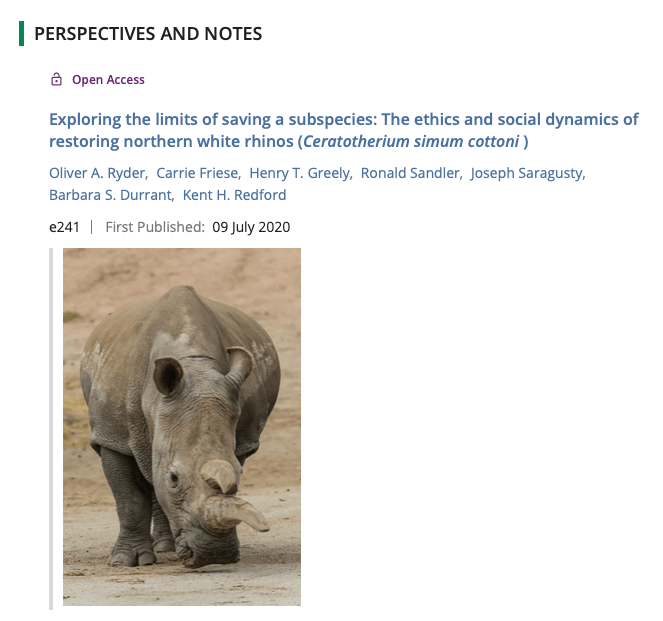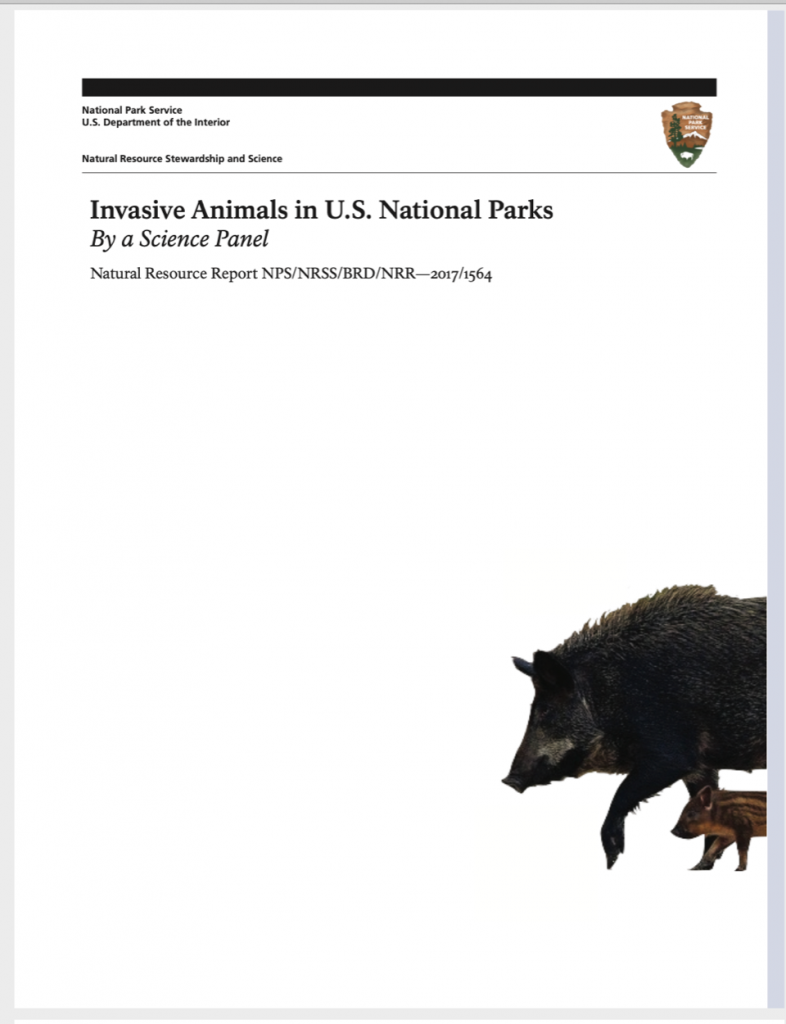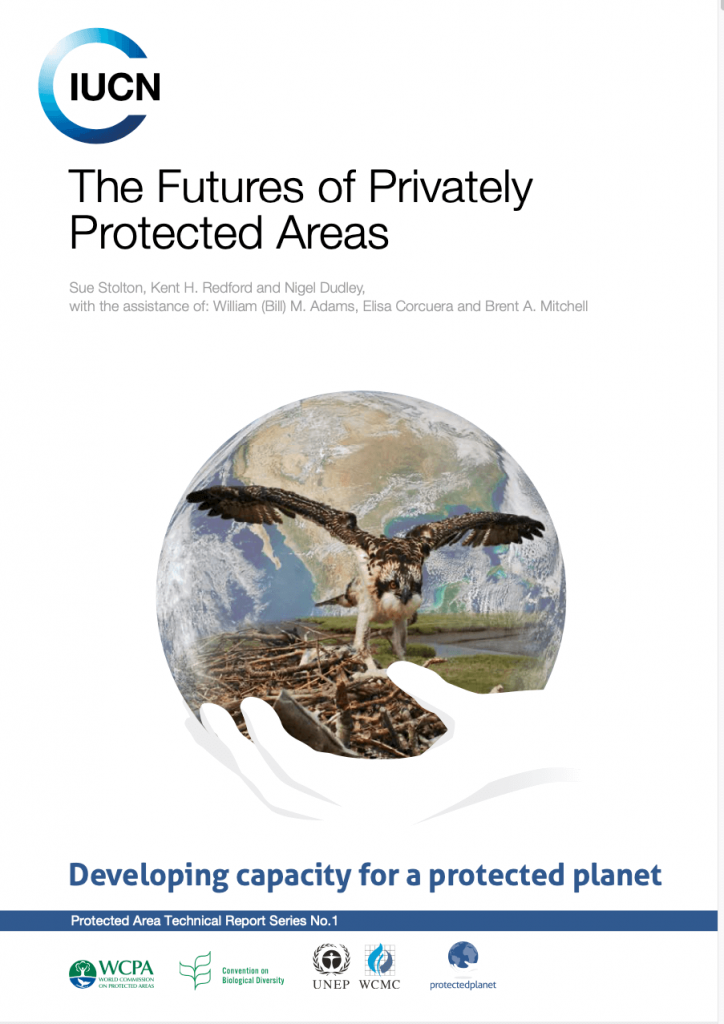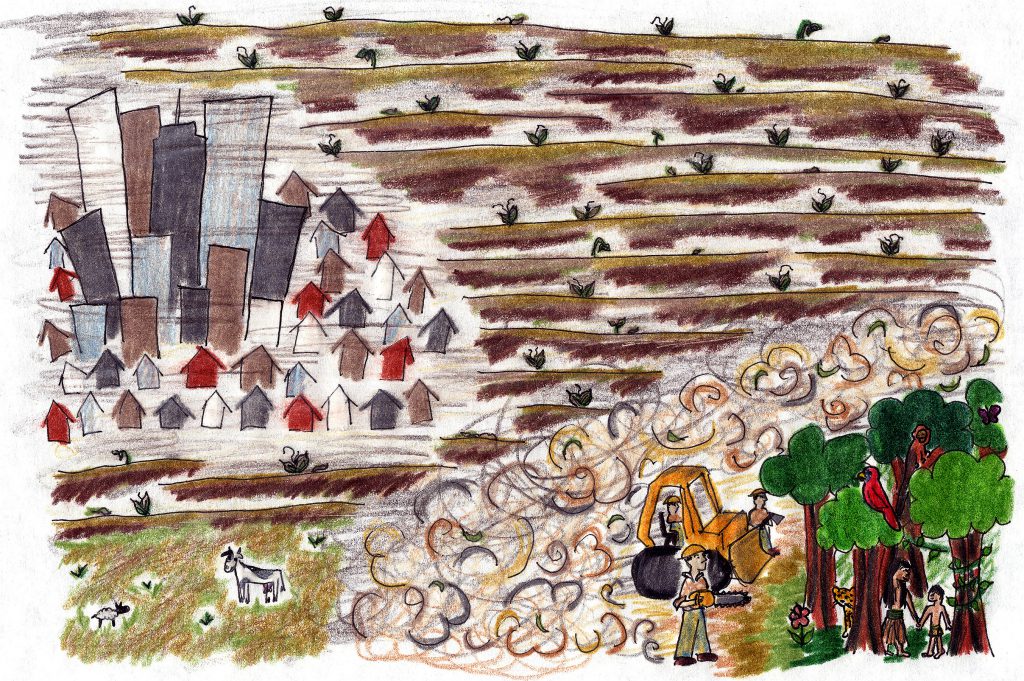
For me writing and publishing is an important part of sharing and helping grow the field of applied conservation. I have been active in publishing in the peer-reviewed literature as I have worked on a wide variety of projects and followed interests of my own.
Selected Publications
2023
- Calhoun, A., Hunter Jr., M. and Redford, K.H. (eds.). 2023. Our Maine. The natural heritage of Maine. Down East Books, Maine.
- Redford, K.H. 2023. Extending conservation to include Earth’s microbiome. Conservation Biology 2023: e14088.
- Diaz J, Redford KH, Reese AT. 2023 Captive and urban environments are associated with distinct gut microbiota in deer mice (Peromyscus maniculatus). Biol. Lett. 19: 20220547. https://doi.org/10.1098/rsbl.2022.0547
2022
- Dudley, N., J. Robinson, S. Andelman et al. (Redford). 2022. Developing an outcomes-based approach to achieving target 13 of the Global Biodiversity Framework. Parks 28.2: 33-44.
- Macfarlane, N.B.W. et al. (Redford). 2022. Direct and indirect impacts of synthetic biology on biodiversity conservation. iScience 25 105423
2021
- Redford, K.H., da Fonseca, G., Gascon, C., Rodriguez, C.M. et al. 2021. Healthy Planet Healthy People. Conservation Letters. e12864.
- Redford, K.H. and Adams, W.A. 2021. Strange Natures: Conservation in the Era of Synthetic Biology. Yale University Press.
- Redford, K.H. and Adams, W.M. 2021. Synthetic biology and nature-based solutions. for COP-26. https://yalebooksblog.co.uk/2021/11/03/cop26-synthetic-biology-and-nature-based-solutions/
- Adams, W.M. and K.H. Redford. 2021. Editing the wild. Conservation Biology 35: 1701-1703 DOI: 10.1111/cobi.13741
- Adams, W.M. and K.H. Redford. Fix that genome! Oryx 481-482. DOI: https://doi.org/10.1017/S0030605321000697
- Kokotovich, A. E., J. A. Delborne, K. Redford, T. Cook, E. Leslie, J. Sieracki, and D. Trevino. 2021. Free-ranging cats: Understanding conflict and the potential for engagement. Natural Resource Report NPS/NRSS/BRD/NRR—2021/2297. National Park Service, Fort Collins, Colorado. https://doi.org/10.36967/nrr-2287250.
- Brodie, J.F., Lieberman, S., Moehrenschlager, A., Redford, K.H., Rodríguez, J.P., Schwartz, M., Seddon, P.J. and Watson, J.E.M. 2021. Global policy for assisted colonization of species. Science 372: 456-458.
- Letter response to “Assisted colonization risk assessment”. Science 372: 925-926.
- Bingham, H.C., Fitzsimons, J.A., Mitchell, B.A., Redford, K.H. and Stolton, S. 2021. Privately protected areas: missing pieces of the global conservation puzzle. Frontiers in Conservation Science 2: 748127
2020

- Ryder, O.A., Friese, C., Greely, H.T. (K.H. Redford) et al. 2020. Exploring the limits of saving a subspecies: The ethics and social dynamics of restoring northern white rhinos (Ceratotherium simum cottoni). Conservation Science and Practice 2020;2:e241.
- Hocking, M., N. Dudley, W. Elliott (K. Redford) et al. 2020. COVID-19 and protected and conserved areas. Parks 26: 7-24.
- Redford, K.H. 2020. Forum: Commentary on “Gene Drives: New and Improved”. Issues in Science and Technology 36(3), Spring 2020
- Redford, K.H. 2019. Hope from bison and human histories. pp. 7-8. In K. Aune and G. Plumb (eds). Theodore Roosevelt and Bison Restoration of the Great Plains. History Press.
2019
- Redford, K.H., Brooks, T.M., Macfarlane, N.B.W. and Adams, J.S. (eds.) (2019). Genetic frontiers for conservation: An assessment of synthetic biology and biodiversity conservation. Technical assessment. Gland, Switzerland: IUCN. xiv + 166pp.
- Schwartz, M.W., K.H. Redford, AND E.F.Leslie. 2019. Fitting the US National Park Service for change. BioScience DOI: 10.1093/biosci/biz071
- Knight, A.T, C.N. Cook, K.H. Redford, D. Biggs et al. 2019. Improving conservation practice with principles and tools from systems thinking and evaluation. Sustainability Science doi.org/10.1007/s11625-019-00676-x
2018

- Brodie, J.F., K.H. Redford and D.F. Doak. 2018. Ecological function analysis: Incorporating species roles into conservation. Trends in Ecology & Evolution 33: 840-850.
- Redford, Kent H., K. Campbell, A. Dayer, C. Dickman, R. Epanchin-Niell, T. Grosholz, D. Hallac, L. Richardson, M. Schwartz. 2017. Invasive animals in U. S. national parks: By a science panel. Natural Resource Report NPS/NRSS/ BRD/NRR—2017/1564. National Park Service, Fort Collins, Colorado.
- Mitchell, B.A., S. Stolton, J. Bezaury-Creel, H.C. Bingham et al. (Kent H. Redford). 2018. Guidelines for privately protected areas. IUCN. Best Practice Protected Area Guidelines Series No. 29.
- Redford, K.H. and G.M. Mace. 2018. Conserving and contesting biodiversity in the Anthropocene. In: Rethinking Environmentalism: Linking Justice, Sustainability, and Diversity, edited by S. Lele et al. Strüngmann Forum Reports, vol. 23, Cambridge, MA: MIT Press
- Merino, L., E. Mwangi, G. M. Mace, I. Lehmann, P. A. Minang, U. Pascual, K. H. Redford, and V. Reyes-García. 2018. Forests and Other High-Diversity Ecosystems. In: Rethinking Environmentalism: Linking Justice, Sustainability, and Diversity, ed. S. Lele, E. S. Brondizio, J. Byrne, G. M. Mace, and J. Martinez-Alier. Strüngmann Forum Reports, vol. 23, J. Lupp, series editor. Cambridge, MA: MIT Press.
2017
- Bingham, H., J.A. Fitzsimons, K.H. Redford, B.A. Mitchell, J. Bezaury-Creel and T.L. Cumming. 2017. Privately protected areas: advances and challenges in guidance, policy and documentation. Parks Journal 23.1: DOI: 10.2305/IUCN.CH.2017.PARKS-23-1HB.en.
- Manfredo, M. et al. (Redford). 2017. Revisiting the challenge of intentional value shift: reply to Ives and Fischer. Conservation Biology 31: 1486–1487.
- Biggs, D. et al. (Redford) 2017. Breaking the deadlock on ivory. An iterative process that recognizes different value systems may help to protect elephants. Science 358 (6369): 1378-1381.
- Independent Science Panel on Invasive Animals (ISPIA). In press. Invasive Animals in U.S. National Parks. U.S. National Park Service. (Chair: Redford, K.H., K. Campbell, A. Dayer, C. Dickman, R. Epanchin-Niell, T. Grosholz, D. Hallac, L. Richardson and M. Schwartz)
- Redford, K.H., K. Hulvey, M. Williamson, M. Schwartz. In press. Assessment of the conservation measures partnership’s effort to improve conservation outcomes through adaptive management. Conservation Biology.
- Redford, K.H. 2017. Misreading the conservation landscape. Pp 227-241. In Larsen, P.B. and D. Brockington. Editors. The Anthropology of Conservation NGOs. Rethinking the Boundaries. Palgrave Macmillan.
2016
- Michael J. Manfredo, Jeremy T. Bruskotter, Tara L. Teel, David Fulton, Shalom H. Schwartz, Robert Arlinghaus, Shigehiro Oishi, Ayse K. Uskul, Kent Redford, Shinobu Kitayama, Leeann Sullivan. 2016. Why we can’t change social values for the sake of conservation. Conservation Biology DOI: 10.1111/cobi.12855
- Piaggio, A.J., G. Segelbacher, P.J. Seddon, L. Alphey, E.L. Bennett, R.H. Carlson, R.M. Friedman, D. Kanavy, R. Phelan, K.H. Redford, M. Rosales, L. Slobodian and K. Wheeler. 2016. Is it time for synthetic biodiversity conservation? Trends in Ecology and Evolution. DOI: 10.1016/j.tree.2016.10.016
- Biggs, D., K. Redford, H. Cheung, J. Watson. 2016. Trump: time to seize environmental gains. Nature. (letter to editor) 540: 341
- Redford, K.H., K. Aune, G. Plumb. 2016. Hope is a bison. Conservation Biology. DOI: 10.1111/cobi.12717
2015
- Redford, K.H., B.J. Huntley, D. Roe, T. Hammond, M. Zimsky, T.E. Lovejoy, G.A.B. da Fonseca, C.M. Rodriguez and R.M. Cowling. 2015. Mainstreaming biodiversity: conservation for the twenty-first century. Frontiers in Ecology and Evolution 3: 137. doi: 10.3389/fevo.2015.00137
- Naeem, S., et al. (K.H. Redford). 2015. Get the science right when paying for nature’s services. Science 347: 1206-1207.
- Roe, D., F. Booker, M. Day, W. Zhou, S. Allebone-Webb, N.A.O. Hill, N. Kumpel, G. Petrokofsky, K. Redford, D. Russell, G. SHepherd, J. Wright and T.C.H. Sunderland. 2015. Are alternate livelihood projects effective at reducing local threats to specified elements of biodiversity and/or improving or maintaining the conservation status of those elements? Environmental Evidence 4:22 DOI 10.1186/s13750-015-0048-1
2014

- Berger, J., S.L. Cain, E. Cheng, P. Dratch, K. Ellison, et al. 2014. Optimism and challenge for science-based conservation of migratory species in and out of U.S. National Parks. Conservation Biology DOI: 10.1111/cobi.12235
- Redford, K.H. 2014. Augury and ambassadors from the near edge of tomorrow. Conservation Letters (February)
- Redford, K.H., S.S. Myers, T.H. Ricketts and S.A. Osofsky. 2014. Human health as a judicious conservation opportunity. Conservation Biology DOI: 10.1111/cobi.12290
- Brodie, J.F., C.E. Aslan, H.S. Rogers, K.H. Redford, J.L. Maron, J.L. Bronstein and C.R. Groves. Secondary extinctions of biodiversity. Trends in Ecology and Evolution. DOI: 10.1016/j.tree.2014.09.012
- Dudley, N., C. Groves, K.H. Redford and S. Stolton. 2014. Where now for protected areas? Setting the stage for the 2014 World Parks Congress. Oryx doi:10.1017/S0030605314000519
- Amend, T. et al. (Kent H. Redford). 2014. Publishing for the protected area community. Parks 20.2: 7-12.
- Myers, S.S., L. Gaffikin, C.D. Golden, R.S. Ostfeld, K.H. Redford, T.H. Ricketts, W.R. Turner and S.A. Osofsky. 2014. Human health impacts of ecosystem alteration. Proc. Nat’l Acad. Sciences doi/10.1073/pnas.1218656110
- Redford, K. H. 2014. Synthetic biology offers extraordinary opportunities and challenges for conservation. Park Science 31(1):30–33.
- Stolton, S., K.H. Redford, and N. Dudley. 2014. The Futures of Privately Protected Areas. IUCN Protected Area Technical Report.
2013
- Redford, K.H., J. Berger and S. Zack. 2013. Abundance as a conservation value. Oryx 47(2): 157–158.
- Redford, K.H., D.B. Jensen and J.J. Breheny. 2013. The long overdue death of the ex-situ and in-situ dichotomy in species conservation. WAZA magazine
- Salafsky, N. and K.H. Redford. 2013. Defining the burden of proof in conservation. Biological Conservation 166: 247- 253.
- Redford, K.H., W. Adams and G.M. Mace. 2013. Synthetic biology and conservation of nature: wicked problems and wicked solutions. PLOS Biology 11 (4): e1001530.
2012
- Ingram, J.C., K.H. Redford and J.Watson. 2012. Implementing the Ecosystem Services Approach for biodiversity conservation and ecosystem management. Sapiens 5.1
- Redford, K.H., J.A. Segre, N. Salafsky, C. Martinez del Rio and D. McAloose. 2012. Conservation and the microbiome. Conservation Biology 26: 195-197.
- Redford, K.H., C. Groves, R. Medellin and J.G. Robinson. 2012. Conservation stories, conservation science, and the role of the Intergovernmental Platform on Biodiversity and Ecosystem Services. Conservation Biology 26: 757-759.
- Redford, K.H., D.B. Jensen and J.J. Breheny. 2012. Integrating the captive and the wild. Science 338: 1157-1158.
- Stephen Woodley, Kathy Mackinnon, Kent Redford, Nigel Dudley, Bastian Bertzky, Sarat Gidda, Nigel Crawhall, Julia Miranda Londono, and Trevor Sandwith. 2012. Meeting Aichi Target 11: What does success look like for protected area systems? Parks 18.1: 23-36.
2011
- Redford, K.H. George Amato, Jonathan Baillie, Pablo Beldomenico, Elizabeth L. Bennett, et al. 2011. What Does It Mean to Successfully Conserve a (Vertebrate) Species? BioScience 61: 39-48.
- Redford, K.H. 2011. Misreading the conservation landscape. Oryx 45(3): 324–330
- Redford, K.H., J. Ray and L. Boitani. 2011. Mapping and navigating mammal conservation: from analysis to action. Phil. Trans. R. Soc. B 2011 366, 2712-2721
- Mockrin, M., and K.H. Redford 2011. Potential for spatial management of hunted mammal populations in tropical forests. Conservation Letters 4 (2011) 255–263.
Synthetic Biology and Conservation
With support of the Wildlife Conservation Society and the help of Bill Adams (Cambridge University) and Georgina Mace (University College London) I organized a global meeting to bring together the conservation community and the synthetic biology community in April, 2013 at Clare College Cambridge. With the help of several experts we produced a framing paper available through WCS as well as other publications listed above.
Some of the papers we have published on this intersection are listed above; others are listed below.
- Redford, K.H. 2013. Remaking nature. The Scientist August 1, 2013: 22-23.
- Redford, K.H., W. Adams, G. Mace, R. Carlson, S. Sanderson and S. Aldrich. 2013. How will synthetic biology and conservation shape the future of nature. Framing Paper for April 2013 meeting.
- Redford, K.H., W. Adams, G. Mace. R. Carlson S. Sanderson and S. Aldrich. 2013. Some say we are in the age of man. Towards a new conservation agenda. Policy Options. September-October 2013: 31-35.
The American Bison Society
Originally founded in 1905 by pioneering conservationists Theodore Roosevelt and William Hornaday, the American Bison Society helped save the bison from extinction. One hundred years later, in 2005, the American Bison Society was re-launched by the Wildlife Conservation Society to secure the ecological future of bison in North America. The Mission: The American Bison Society works with a broad range of partners to build the scientific and social bases to achieve ecological restoration of North American bison.
The Futures Group – Wildlife Conservation Society
WCS Futures Group and Bio-Era. 2007. Futures of the Wild. A project of the Wildlife Conservation Society Futures Group.
A formal scenario process that generated the report outlining six future scenarios that might affect the ability of WCS to achieve its mission. The scenarios were defined by assumptions about three major uncertainties (environmental change, cultural and societal attitudes and new technologies) and explore the ways in which conservation activities and strategies may shift in the decades ahead in response to changes in global circumstances and the dynamics of the major uncertainties.
Available in pdf format upon request
Wildlife Conservation Society Working Papers
Redford, Kent H. and Michael Painter. 2006. Natural alliances between conservationists and indigenous peoples. WCS Working Paper No. 25. New York: Wildlife Conservation Society.
Agrawal, Arun and Kent Redford. 2006. Poverty, development, and biodiversity conservation: Shooting in the dark? WCS Working Paper No. 26. New York: Wildlife Conservation Society.
Redford, Kent H., and Eva Fearn, eds. 2007. Protected areas and human displacement: A conservation perspective. WCS Working Paper No. 29. New York: Wildlife Conservation Society.
Redford, Kent H., and Eva Fearn, eds. 2007. Protected areas and human livelihoods. WCS Working Paper No. 30. New York: Wildlife Conservation Society.
Redford, Kent H., and Catherine Grippo, eds. 2008. Protected areas, governance, and scale. WCS Working Paper No. 36. New York: Wildlife Conservation Society.
(selected titles; available in pdf format on request)
Parks in Peril
Brandon, K., K.H. Redford and S.E. Sanderson. eds. 1998. Parks in Peril. People, Politics, and Protected Areas. Island Press.
Using the experience of the Parks in Peril program — a wide-ranging project instituted by The Nature Conservancy and its partner organizations in Latin America and the Caribbean to foster better park management — this book presents a broad analysis of current trends in park management and the implications for biodiversity conservation. It examines the context of current park management and challenges many commonly held views from social, political, and ecological perspectives. The book argues that: biodiversity conservation is inherently political; sustainable use has limitations as a primary tool for biodiversity conservation; effective park protection requires understanding the social context at varying scales of analysis; and actions to protect parks need a level of conceptual rigor that has been absent from recent programs built around slogans and stereotypes.
Nine case studies highlight the interaction of ecosystems, local peoples, and policy in park management, and describe the context of field-based conservation from the perspective of those actually implementing the programs. “Parks in Peril” builds from the case studies and specific park-level concerns to a synthesis of findings from the sites. The editors draw on the case studies to challenge popular conceptions about parks and describe future directions that can ensure long-term biodiversity conservation.
State of the Wild
How do we gauge the state of earth’s wildlife, wildlands, and oceans? State of the Wild is a biannual series that brings together some of the world’s most renowned conservationists and writers-George Schaller, Alan Rabinowitz, Sylvia Earle, Rick Bass, Bill McKibben, Tom Lovejoy, and many others-to assess wildlife and wilderness, and to provide insights into how humans can become better stewards of the wild.
This publication combines evocative writings with a fascinating tour of news highlights and vital statistics from around the world. One-third of each volume focuses on a topic of particular concern to conservationists working to protect wildlife and our last wild places. Three editions were published, in 2006, 2008 and 2010.
Selected Older Redford Publications
Redford, K.H., J. Ray and L. Boitani. 2011. Mapping and navigating mammal conservation: from analysis to action. Phil. Trans. R. Soc. B 2011 366, 2712-2721
Redford, K.H. George Amato, Jonathan Baillie, Pablo Beldomenico, Elizabeth L. Bennett, Nancy Clum, Robert Cook, Gustavo Fonseca, Simon Hedges, Frederic Launay, Susan Lieberman, Georgina M. Mace, Akira Murayama, Andrea Putnam, John G. Robinson, Howard Rosenbaum, Eric W. Sanderson, Simon N. Stuart, Patrick Thomas, John Thorbjarnarson. 2011. What Does It Mean to Successfully Conserve a (Vertebrate) Species? BioScience 61: 39-48.
Redford, K.H. 2011. Misreading the conservation landscape. Oryx 45: 325-330.
Redford, K.H., and W. Adams. 2009. Payment for ecosystem services and the challenge of saving nature. Conservation Biology 23(4): 785-787.
Redford, Kent H., Marc A. Levy, Eric W. Sanderson, and Alex de Sherbinin. 2008. What is the role for conservation organizations in poverty alleviation in the world’s wild places? Oryx 42(4): 516-528.
Redford, K.H., P. Coppolillo, E.W. Sanderson, G.A.B. da Fonseca, E. Dinerstein, C. Groves, G. Mace, S. Maginnis, R.A. Mittermeier, R. Noss, D. Olson, J.G. Robinson, A. Vedder, Michael Wright. 2003. Mapping the conservation landscape. Conservation Biology 17(1): 116-131
Copyright restrictions prohibit providing complete articles but scholar.google.com makes many papers available or the sites of the individual journals provide details on how to obtain copies.


